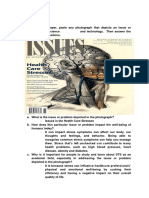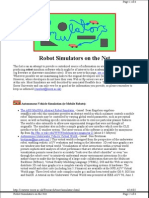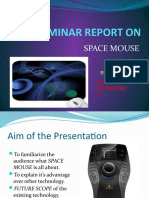0 ratings0% found this document useful (0 votes)
51 viewsGroup Activity STS
The document discusses two emerging ethical dilemmas:
1) Robot abuse, which refers to physical, verbal, or functional harm directed towards robots. Increased robot integration and a lack of guidelines have introduced this dilemma. It could desensitize people to violence or impact cultural views of technology.
2) Doomscrolling, the habit of excessive negative news consumption on social media. Constant smartphone access and algorithm prioritization of sensational content fuel this issue. It impacts mental health, social cohesion, and productivity.
Studying science, technology, and society is important as it provides a holistic understanding of these dilemmas and their social implications. This allows for more informed policymaking and strategies to guide responsible
Uploaded by
Ypriel Jane Bolonos LunaCopyright
© © All Rights Reserved
Available Formats
Download as DOCX, PDF, TXT or read online on Scribd
0 ratings0% found this document useful (0 votes)
51 viewsGroup Activity STS
The document discusses two emerging ethical dilemmas:
1) Robot abuse, which refers to physical, verbal, or functional harm directed towards robots. Increased robot integration and a lack of guidelines have introduced this dilemma. It could desensitize people to violence or impact cultural views of technology.
2) Doomscrolling, the habit of excessive negative news consumption on social media. Constant smartphone access and algorithm prioritization of sensational content fuel this issue. It impacts mental health, social cohesion, and productivity.
Studying science, technology, and society is important as it provides a holistic understanding of these dilemmas and their social implications. This allows for more informed policymaking and strategies to guide responsible
Uploaded by
Ypriel Jane Bolonos LunaCopyright
© © All Rights Reserved
Available Formats
Download as DOCX, PDF, TXT or read online on Scribd
You are on page 1/ 4
Group member
Arano, Carlos Miguel
Estrope, Cristha
Lacbao, Bea
Luna, Ypriel Jane
Quirim, Heart Micah
3BSE-E
March 12, 2024
Ethical Dilemma: Robot Abuse
1. What is the emerging ethical dilemma all about?
Bullying and violence between humans and robots is referred to as "robot
abuse." It typically happens as follows: first, a human punches, kicks, or engages
in other aggressive behavior directed at a robot, which is referred to as physical
abuse. Second, despite the fact that robots are not supposed to be sentient,
calling them names and using other disparaging language which is commonly
known as verbal abuse. Last but not least, another type of robot is one that gets
harmed and ceases to function when someone subverts them while they are
operating as planned.
2. What factors or events led to the introduction of this dilemma?
The introduction of the robot abuse dilemma can be attributed to several factors
and events in the development and integration of robotics and artificial
intelligence into various aspects of society. Some key factors include:
Increased use of robots in various industries
Humanization of robots
Lack of clear guidelines and regulations
Ethical considerations in human-robot interactions
As robotics and AI continue to evolve, it is essential to address these ethical
dilemmas and establish guidelines to ensure the responsible and ethical
treatment of robots in various contexts.
3. What are the social, political, economic, or cultural implications of this dilemma?
Social Implications:
Witnessing or being aware of robot abuse may desensitize individuals to
violence, potentially impacting their behavior towards humans.
Political Implications:
Governments may need to establish laws and regulations to protect robots
from abuse, similar to animal welfare laws.
Economic Implications:
Industries employing robots may face reputational damage or boycotts if
they are perceived involved in or cause negligent towards robot abuse.
Cultural Implications:
Cultural attitudes towards technology and its role in society may shift, as
people are affected with the implications of mistreating artificial beings
4. Why is it important to question the moral and ethical issues surrounding
your assigned science and technology innovation?
Questioning the ethical issues surrounding robot abuse is crucial for multiple
reasons, including reflecting on human behavior, setting ethical precedents for
future interactions with AI, avoiding desensitization to violence, contemplating AI
rights, encouraging ethical design in development, and understanding the social
and cultural impacts of integrating robots into society. It prompts critical thinking
about our responsibilities and the potential consequences of our actions on non-
sentient beings, influencing how we might interact with future sentient AI and
ensuring technology enhances the human experience in ethical and
compassionate ways.
5. In the face of this dilemma, why is it important to study STS?
Studying STS is crucial in addressing the robot abuse dilemma because it
provides a holistic perspective on the social, ethical, and political implications of
technology. It allows us to understand the human-robot interaction, how people
perceive and treat robots, and the potential consequences of such behavior. By
examining these issues through the lens of STS, we can develop guidelines and
policies that promote responsible and ethical use of robots. It also helps us
anticipate future challenges and devise strategies to mitigate them, ensuring that
the advancement of robotics technology is beneficial and respectful to all
stakeholders.
Ethical Dilemma: Doomscrolling
1. What is the emerging ethical dilemma all about?
Doomscrolling refers to the habit of endlessly scrolling through negative news or
social media feeds, often leading to increased anxiety, stress, and a sense of
hopelessness. It usually happens when you're surrounded by bad news, you may
find yourself reading every little detail about it.
2. What factors or events led to the introduction of this dilemma?
Doomscrolling or the excessive consumption of negative news on social media,
can be attributed to several factors and events. Firstly, the rise of social media
platforms and their constant accessibility through smartphones has made it
easier for people to stay connected and informed. However, the algorithms used
by these platforms often prioritize sensational and emotionally charged content,
which tends to be negative. This, coupled with the human tendency to be
attracted to negative information for survival reasons, can lead to a cycle of
doomscrolling. Additionally, significant events such as natural disasters, political
unrest, and the COVID-19 pandemic have generated a constant stream of
distressing news, fueling the urge to stay updated and contributing to the
prevalence of doomscrolling.
3. What are the social, political, economic, or cultural implications of this
dilemma?
Doomscrolling, the habit of constantly consuming negative news online, has
broad implications for society, affecting mental health, leading to isolation and
social polarization. Politically, it can skew public opinion, deepen polarization,
and cause disengagement from issues. Economically, it impacts productivity,
influences media consumption patterns, and can alter consumer behavior.
Culturally, it fosters pessimism, normalizes crises, and may shift societal values
towards risk aversion, potentially inhibiting innovation. Addressing these effects
necessitates a comprehensive strategy, including improving media literacy,
promoting digital wellness, and fostering balanced media consumption.
4. Why is it important to question the moral and ethical issues surrounding
your assigned science and technology innovation?
We need to question the moral and ethical issues surrounding doomscrolling
help us somewhat balance our usage of social media to not compromise the time
that is intended for most important things.
5. In the face of this dilemma, why is it important to study STS?
In the face of the doomscrolling dilemma, it is important to study Science,
Technology, and Society (STS) for several reasons.
By studying STS, individuals can gain a deeper understanding of how
technology shapes our lives and society, as well as the potential
consequences of our reliance on digital devices and online platforms.
STS also encourages individuals to consider the broader societal
implications of technological developments, such as issues related to
privacy, surveillance, misinformation, and algorithmic bias.
In essence, studying STS provides individuals with the tools to navigate the
complexities of our technologically driven world, critically analyze the effects
of technology on society and individuals, and make informed decisions
about their digital consumption habits, including how to address the
doomscrolling dilemma.
You might also like
- RANGER 5 AXIS ROBOT OPERATIONS MANUAL AB VERSION REV 2.7 Euro0% (1)RANGER 5 AXIS ROBOT OPERATIONS MANUAL AB VERSION REV 2.7 Euro87 pages
- The Digital Republic: On Freedom and Democracy in the 21st CenturyFrom EverandThe Digital Republic: On Freedom and Democracy in the 21st CenturyNo ratings yet
- Digital Dilemmas: Navigating Ethics in the Age of AI and SurveillanceFrom EverandDigital Dilemmas: Navigating Ethics in the Age of AI and SurveillanceNo ratings yet
- 1+Introduction+to+STS+%28students+copy%29No ratings yet1+Introduction+to+STS+%28students+copy%2942 pages
- Artificial Intelligence Ethics - Navigating Moral Dilemmas in a Digital WorldFrom EverandArtificial Intelligence Ethics - Navigating Moral Dilemmas in a Digital WorldNo ratings yet
- Cracking Social Mobility: How AI and Other Innovations Can Help to Level the Playing FieldFrom EverandCracking Social Mobility: How AI and Other Innovations Can Help to Level the Playing FieldNo ratings yet
- APA-AP - Activity 3-Emerging Ethical and Policy Issues of STSNo ratings yetAPA-AP - Activity 3-Emerging Ethical and Policy Issues of STS36 pages
- The Impact Of Artificial Intelligence The Rise of the Machines:From EverandThe Impact Of Artificial Intelligence The Rise of the Machines:No ratings yet
- Living with the Algorithm: Servant or Master?: AI Governance and Policy for the FutureFrom EverandLiving with the Algorithm: Servant or Master?: AI Governance and Policy for the FutureNo ratings yet
- Social media: Advantages and disadvantages of digital communicationFrom EverandSocial media: Advantages and disadvantages of digital communicationNo ratings yet
- Introduction To Science, Technology and Society: John Heilbron (2003)No ratings yetIntroduction To Science, Technology and Society: John Heilbron (2003)4 pages
- Exercise 3. Issues in Science and Technology (Group Work) Instructions: Form Groups With 2-3 Members. Review The 10 Immerging Ethical andNo ratings yetExercise 3. Issues in Science and Technology (Group Work) Instructions: Form Groups With 2-3 Members. Review The 10 Immerging Ethical and2 pages
- Mastering Cyberbullying: A Comprehensive Guide for Dealing with Online HarassmentFrom EverandMastering Cyberbullying: A Comprehensive Guide for Dealing with Online HarassmentNo ratings yet
- Risks Associated with Artifical Intelligence and RoboticsFrom EverandRisks Associated with Artifical Intelligence and RoboticsNo ratings yet
- Macaisa-When Technology and Humanity CrossNo ratings yetMacaisa-When Technology and Humanity Cross11 pages
- Navigating The AI Revolution: Ethics, Opportunities and ChallengesFrom EverandNavigating The AI Revolution: Ethics, Opportunities and ChallengesNo ratings yet
- Poel - 2016 - An Ethical Framework For Evaluating Experimental TechnologyNo ratings yetPoel - 2016 - An Ethical Framework For Evaluating Experimental Technology20 pages
- Digital Detox: Reclaiming Your Life in a Hyperconnected WorldFrom EverandDigital Detox: Reclaiming Your Life in a Hyperconnected WorldNo ratings yet
- Digital Influence Mercenaries: Profits and Power Through Information WarfareFrom EverandDigital Influence Mercenaries: Profits and Power Through Information WarfareNo ratings yet
- The Loneliness Antidote: The Neuroscience of Loneliness and the Art of Human ConnectionFrom EverandThe Loneliness Antidote: The Neuroscience of Loneliness and the Art of Human ConnectionNo ratings yet
- Microaggressions and Marginality: Manifestation, Dynamics, and ImpactFrom EverandMicroaggressions and Marginality: Manifestation, Dynamics, and ImpactNo ratings yet
- In This Course You Will Learn The FollowingNo ratings yetIn This Course You Will Learn The Following9 pages
- Nhóm 6. Digital Twins For Collaborative Robots A Case Study in Human-Robot InteractionNo ratings yetNhóm 6. Digital Twins For Collaborative Robots A Case Study in Human-Robot Interaction20 pages
- Use of Robot Kits in Manufacturing Industry-CIMNo ratings yetUse of Robot Kits in Manufacturing Industry-CIM11 pages
- Automation Studio P9 Brochure English HighNo ratings yetAutomation Studio P9 Brochure English High32 pages
- Dynamic Model Identification For Industrial Robots: Integrated Experiment Design and Parameter EstimationNo ratings yetDynamic Model Identification For Industrial Robots: Integrated Experiment Design and Parameter Estimation14 pages
- ROBOTIC ARM TRAJECTORY TRACKING USING IMAGE D KarayelNo ratings yetROBOTIC ARM TRAJECTORY TRACKING USING IMAGE D Karayel9 pages
- 182892-1 - Conveyor Synchronized Function - READ FIRSTNo ratings yet182892-1 - Conveyor Synchronized Function - READ FIRST1 page
- Investigation of Design & Fabrication of In-Pipe Inspection Robot100% (1)Investigation of Design & Fabrication of In-Pipe Inspection Robot4 pages
- Balancing Control of A Two Wheeled Mobile Robot SystemNo ratings yetBalancing Control of A Two Wheeled Mobile Robot System7 pages
- Beginner Guide Mimic Training Kit Nordbo RoboticsNo ratings yetBeginner Guide Mimic Training Kit Nordbo Robotics15 pages
- RANGER 5 AXIS ROBOT OPERATIONS MANUAL AB VERSION REV 2.7 EuroRANGER 5 AXIS ROBOT OPERATIONS MANUAL AB VERSION REV 2.7 Euro
- The Digital Republic: On Freedom and Democracy in the 21st CenturyFrom EverandThe Digital Republic: On Freedom and Democracy in the 21st Century
- Digital Dilemmas: Navigating Ethics in the Age of AI and SurveillanceFrom EverandDigital Dilemmas: Navigating Ethics in the Age of AI and Surveillance
- Empowering Ethics in AI: A Guide for EveryoneFrom EverandEmpowering Ethics in AI: A Guide for Everyone
- Artificial Intelligence Ethics - Navigating Moral Dilemmas in a Digital WorldFrom EverandArtificial Intelligence Ethics - Navigating Moral Dilemmas in a Digital World
- Cracking Social Mobility: How AI and Other Innovations Can Help to Level the Playing FieldFrom EverandCracking Social Mobility: How AI and Other Innovations Can Help to Level the Playing Field
- APA-AP - Activity 3-Emerging Ethical and Policy Issues of STSAPA-AP - Activity 3-Emerging Ethical and Policy Issues of STS
- The Impact Of Artificial Intelligence The Rise of the Machines:From EverandThe Impact Of Artificial Intelligence The Rise of the Machines:
- Frontiers: Navigating the Morality of AI and BiotechnologyFrom EverandFrontiers: Navigating the Morality of AI and Biotechnology
- Digital Liberty: Power, Wealth and the Influence MachineFrom EverandDigital Liberty: Power, Wealth and the Influence Machine
- Living with the Algorithm: Servant or Master?: AI Governance and Policy for the FutureFrom EverandLiving with the Algorithm: Servant or Master?: AI Governance and Policy for the Future
- Social media: Advantages and disadvantages of digital communicationFrom EverandSocial media: Advantages and disadvantages of digital communication
- "The Sociology of Information Technology": GoodMan, #1From Everand"The Sociology of Information Technology": GoodMan, #1
- Navigating Social Media, A Guide to the Digital LandscapeFrom EverandNavigating Social Media, A Guide to the Digital Landscape
- Introduction To Science, Technology and Society: John Heilbron (2003)Introduction To Science, Technology and Society: John Heilbron (2003)
- Social Warming: How Social Media Polarises Us AllFrom EverandSocial Warming: How Social Media Polarises Us All
- Exercise 3. Issues in Science and Technology (Group Work) Instructions: Form Groups With 2-3 Members. Review The 10 Immerging Ethical andExercise 3. Issues in Science and Technology (Group Work) Instructions: Form Groups With 2-3 Members. Review The 10 Immerging Ethical and
- Mastering Cyberbullying: A Comprehensive Guide for Dealing with Online HarassmentFrom EverandMastering Cyberbullying: A Comprehensive Guide for Dealing with Online Harassment
- Gale Researcher Guide for: The Sociological PerspectiveFrom EverandGale Researcher Guide for: The Sociological Perspective
- Risks Associated with Artifical Intelligence and RoboticsFrom EverandRisks Associated with Artifical Intelligence and Robotics
- Navigating The AI Revolution: Ethics, Opportunities and ChallengesFrom EverandNavigating The AI Revolution: Ethics, Opportunities and Challenges
- Poel - 2016 - An Ethical Framework For Evaluating Experimental TechnologyPoel - 2016 - An Ethical Framework For Evaluating Experimental Technology
- Digital Detox: Reclaiming Your Life in a Hyperconnected WorldFrom EverandDigital Detox: Reclaiming Your Life in a Hyperconnected World
- Big Tech Exposed: How Algorithms Control Your Mind & MoneyFrom EverandBig Tech Exposed: How Algorithms Control Your Mind & Money
- Digital Influence Mercenaries: Profits and Power Through Information WarfareFrom EverandDigital Influence Mercenaries: Profits and Power Through Information Warfare
- Psycho-social Dynamics of Cybercrime: 1A, #1From EverandPsycho-social Dynamics of Cybercrime: 1A, #1
- The Loneliness Antidote: The Neuroscience of Loneliness and the Art of Human ConnectionFrom EverandThe Loneliness Antidote: The Neuroscience of Loneliness and the Art of Human Connection
- Microaggressions and Marginality: Manifestation, Dynamics, and ImpactFrom EverandMicroaggressions and Marginality: Manifestation, Dynamics, and Impact
- Nhóm 6. Digital Twins For Collaborative Robots A Case Study in Human-Robot InteractionNhóm 6. Digital Twins For Collaborative Robots A Case Study in Human-Robot Interaction
- Dynamic Model Identification For Industrial Robots: Integrated Experiment Design and Parameter EstimationDynamic Model Identification For Industrial Robots: Integrated Experiment Design and Parameter Estimation
- ROBOTIC ARM TRAJECTORY TRACKING USING IMAGE D KarayelROBOTIC ARM TRAJECTORY TRACKING USING IMAGE D Karayel
- 182892-1 - Conveyor Synchronized Function - READ FIRST182892-1 - Conveyor Synchronized Function - READ FIRST
- Investigation of Design & Fabrication of In-Pipe Inspection RobotInvestigation of Design & Fabrication of In-Pipe Inspection Robot
- Balancing Control of A Two Wheeled Mobile Robot SystemBalancing Control of A Two Wheeled Mobile Robot System

























































































